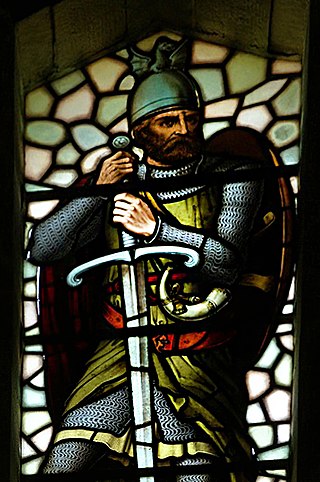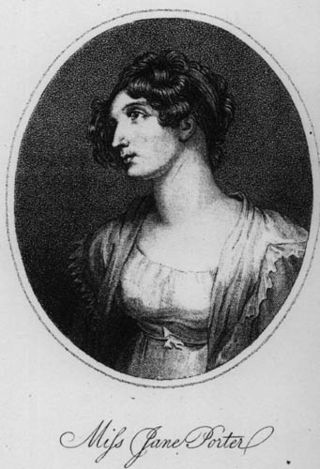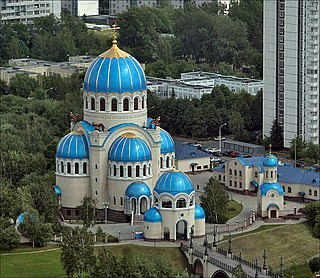
Sir William Wallace was a Scottish knight who became one of the main leaders during the First War of Scottish Independence.

A lamington is an Australian cake made from squares of butter cake or sponge cake coated in an outer layer of chocolate sauce and rolled in desiccated coconut. The thin mixture is absorbed into the outside of the sponge cake and left to set, giving the cake a distinctive texture. A common variation has a layer of cream or strawberry jam between two lamington halves.

Lanarkshire, also called the County of Lanark, is a historic county, lieutenancy area and registration county in the Central Lowlands and Southern Uplands of Scotland. The county is no longer used for local government purposes, but gives its name to the two modern council areas of North Lanarkshire and South Lanarkshire.

Jane Porter was an English historical novelist, dramatist and literary figure. Her bestselling novels, Thaddeus of Warsaw (1803) and The Scottish Chiefs (1810) are seen as among the earliest historical novels in a modern style and among the first to become bestsellers. They were abridged and remained popular among children well into the twentieth century.

The Archdiocese of Glasgow was one of the thirteen dioceses of the Scottish church. It was the second largest diocese in the Kingdom of Scotland, including Clydesdale, Teviotdale, parts of Tweeddale, Liddesdale, Annandale, Nithsdale, Cunninghame, Kyle, and Strathgryfe, as well as Lennox, Carrick and the part of Galloway known as Desnes.

The A702 is a major road in Scotland, that runs from Edinburgh to St. John's Town of Dalry in Dumfries and Galloway. It is the last section of the route from London via the West Midlands and North West England to Edinburgh, which follows the M1, M6, A74(M) and finally the A702.

Loudoun Castle is a ruined country house nicknamed the "Windsor of Scotland" located near Galston, in the Loudoun area of Ayrshire, Scotland. The majority of the building was constructed from 1804 to 1811 around existing structures dating to the 15th and 17th centuries. The building was destroyed by fire in 1942 and never rebuilt, while the rest of the property was converted into the Loudoun Castle theme park in 1995 and closed in 2010. The ruins are protected as a category A listed building.

Glenveagh Castle is a large castellated mansion located in Glenveagh National Park, County Donegal, Ireland and was built in about 1870.

Bonnington is a district of Edinburgh, the capital of Scotland. The area centres upon an original village which grew up around a ford on the Water of Leith, on the old boundary between Edinburgh and the port of Leith. Before the creation of Leith Walk, the road via the villages of Broughton and Bonnington, or Wester Road as it appears on some old maps, was one of two roads formerly connecting Edinburgh to Leith; the other being Easter Road. The district lies between the districts of Pilrig and Newhaven.

Comely Bank is an area of Edinburgh, the capital of Scotland. It lies southwest of Royal Botanic Garden and is situated between Stockbridge and Craigleith. It is bound on its northernmost point by Carrington Road and on its southernmost point by Learmonth Terrace. The area is covered by Stockbridge and Inverleith Community Council.

Orekhovo-Borisovo Severnoye District, commonly known as Orekhovo-Borisovo, is a district in Southern Administrative Okrug of Moscow, Russia, located on the spot of former villages of Orekhovo, Borisovo, Shipilovo, Zyablikovo, and Brateyevo. In the early 1970s, mass housing construction was started in the area, and a microdistrict was built. Its main landmark is the Orekhovo-Borisovo Cathedral. The area of the district is 7.540 square kilometres (2.911 sq mi).

Middlebie is a hamlet and parish in the historic county of Dumfriesshire in Dumfries and Galloway, south-west Scotland. It is approximately 2 miles (3.2 km) east of Ecclefechan, and 6 miles (9.7 km) north-east of Annan, on the banks of the Middlebie Burn.

Charles Wallace Alexander Napier Cochrane-Baillie, 2nd Baron Lamington,, was a British politician and colonial administrator who served as Governor of Queensland from 1896 to 1901, and Governor of Bombay from 1903 to 1907.
The Capitulation of Irvine was an early armed conflict of the Wars of Scottish Independence which took place on 7 June 1297. Due to dissension among the Scottish leadership, it resulted in a stand-off.
The action at Lanark was an attack at Lanark, Scotland during the First War of Scottish Independence in May 1297. The Scotsman William Wallace led an uprising against the English and killed the Sheriff of Lanark, William Heselrig. The attack was not an isolated incident, but rather saw Wallace joining in with uprisings taking place across Scotland.

Closeburn is a village and civil parish in Dumfries and Galloway, Scotland. The village is on the A76 road 2+1⁄2 miles (4 km) south of Thornhill. In the 2001 census, Closeburn had a population of 1,119. Closeburn is recorded as Killosbern in 1185. The first element of the name is Gaelic cill 'cell or church'. The second element is a saint's name, but none has definitely been identified.

Cambria State Marine Conservation Area (SMCA) is a marine protected area located off the coast of the city of Cambria, California on California’s central coast in San Luis Obispo County, California. The marine protected area covers 6.26 square miles (16.2 km2). Within the SMCA recreational fishing and take is allowed while commercial fishing and take of all living marine resources is prohibited.
West Ely is an unincorporated community in Marion County, in the U.S. state of Missouri.
Kaledran Creek is a short creek in Anamur ilçe (district) of Mersin Province, south Turkey.
Lamington Tower was a 16th-century tower house, constructed by William Baillie of Lamington, near Lamington, South Lanarkshire, Scotland. The tower house was occupied until the 18th century when it was blown up to provide building materials.















